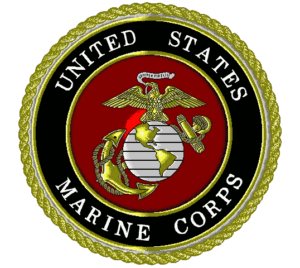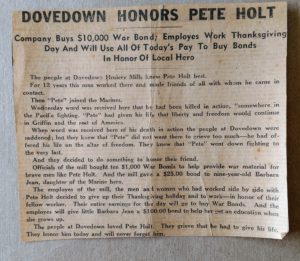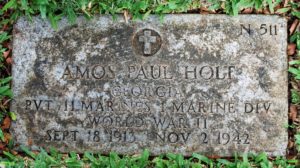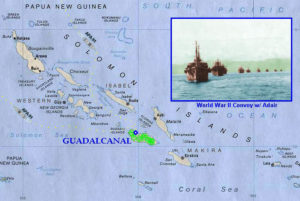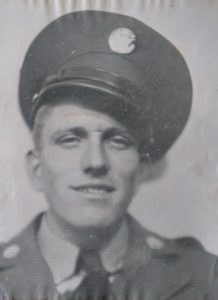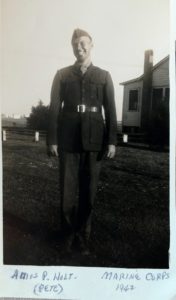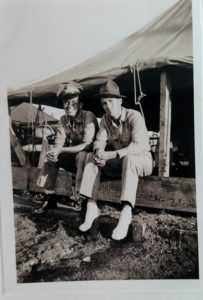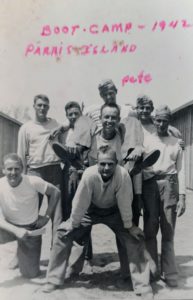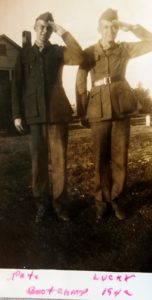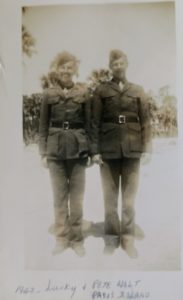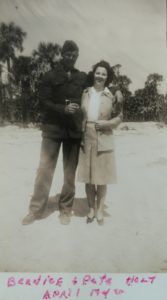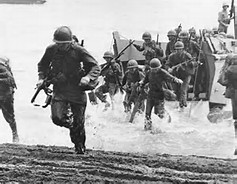Marine PFC Amos Paul Holt
Our Hometown Heroes
Amos Paul Holt
Killed in Battle of Guadalcanal Dovedown Hoisery Mills Honored Their Fallen Friend
Born on September 18, 1913, US Marines Corps PFC Amos Paul Holt, (nicknamed Pete to his friends), fought and was killed in one of the fiercest battles in all of World War II. The Battle of Guadalcanal, part of the Solomon Islands in the Pacific Ocean, is considered one of the most important battles of World War II against the Japanese.
The 1920 Census lists the family living on Hammock Street in Griffin. Wesley Holt was listed as the head of the household and Amos Paul’s father. Hattie was Wesley’s wife. The couple had four sons at the time; Dennis, Clarence, Amos and baby Charlie. Wesley’s occupation is listed as working in the local Griffin, “Cotton Mill.”
Holt enlisted in the Marines. He was married to Mrs. Bernice Sparks Holt who lived at 1020 Broad Street, Griffin. The couple took out a marriage license in December 1931, and were married the following June 24, 1932. D.B. Wallace, Ordinary (today named Probate Court Judge), signed the license.
The 1940 census lists Mr. and Mrs. Amos Paul Holt living on Hammock Street. They had a six-year-old daughter, Bobby (possibly misspelled and should be Bobbie). Amos Paul worked as a looper at Dovedown Mills.
Soon after he joined the Marines, PFC Holt would find himself and his fellow Marines fighting on Guadalcanal on the Solomon Islands.
The official Guadalcanal website http://www.guadalcanal.com/battleofguadalcanal.html
describes the battle as follows:
“The first major offensive launched by the Allies against Japan in World War II took place on Guadalcanal from August 7, 1942, to February 9, 1943. Since the attack on Pearl Harbor on December 7, 1941, the Japanese had advanced toward the South Pacific, threatening the Allies’ South Pacific ferry route connecting Australia and the United States.
In May and June, 1942, the U.S. Navy made headway against the Japanese advance in the Battles of the Coral Sea and Midway. These successes led the U.S. military to pursue a two-pronged assault in the Solomon Islands and New Guinea.
Guadalcanal, in the Solomon Islands, invaded by the Japanese in July, 1942, was one of the most important Japanese strongholds due to its proximity to Australia. The Japanese built an airfield at Lunga Point and artillery positions in the hills nearby and had about 8,400 men on the island by August.
On August 7, 1942, U.S. Marines landed on the northern beaches of Guadalcanal after Navy ships fired onto the island ahead of them. Over the next three months, the Marines secured the airfield and a 6 mile wide section of the beach.
On October 13, an Army unit arrived to reinforce the Marines. The Marines and Army soldiers repelled a Japanese attack on the 23rd, inflicting heavy losses on the Japanese and pushing the Japanese out further during the rest of the month.
On November 4th, the U.S. Infantry fought 1,500 Japanese troops that landed on the beach at Koli Point. They killed half the Japanese force. The rest escaped into the jungle.
In mid-November, the U.S. Navy fought the Japanese at the Battle of Guadalcanal, when the Japanese attempted a major reinforcement of troops via the “Tokyo Express” run of supply-laden destroyers.
In this four-day battle, the U.S. Navy foiled the reinforcement effort, and only 4,000 of 10,000 Japanese troops reached land.
After this battle, the American troops pushed on in an effort to take Mount Austen. Thrashing through the jungle, they faced heavy fire from Japanese troops.
Finally, during the first two days of 1943, in a two-pronged attack on the Mount Austen stronghold at Gifu, American troops succeeded in securing most of the Gifu area and the west slopes of the mountain.
Overall, between 400 and 500 Japanese troops died and over 100 American troops died in the effort to take Mount Austen.
During January 1943, the American troops battled Japanese strongholds on Mount Austen to take areas known as Galloping Horse and Sea Horse and secure the Gifu area.
In the third week of January, the American troops took the Japanese headquarters at Kokumbona.
American troops mounted attacks by land and sea to annihilate the Japanese, but in the end, about 13,000 Japanese troops escaped.
Nevertheless, by February 9, 1943, the U.S. troops took control of the island, helping to turn back the Japanese drive toward Australia and secure a base from which to launch attacks at the Japanese in the South Pacific.
All told, 1,592 American troops were killed in action and 4,183 were wounded.
Thousands more were disabled by tropical diseases like malaria.
The Japanese lost 14,800 in battle and 9,000 from disease. About 1,000 Japanese men were taken prisoner.
__________________
Marine PFC Amos Paul Holt was killed early in the battle on November 2, 1942. His body was found and delivered to the American Cemetery of the Pacific in Honolulu, Hawaii on February 28, 1949, Section N, Lot 511. This is where he is buried.
A special tribute from those who loved him
As a tribute to Holt, the employees of Dovedown Mills bought $10,000 worth of War Bonds. Here is the story about their donation and love of the man they called, friend. “The people of Dovedown Hoisery Mills knew “Pete” Holt best. For 12-years this man worked there and made friends of all with whom he came in contact. Then Pete joined the Marines.
Wednesday word was received here that he had been killed in action, “somewhere in the Pacific,” fighting. Pete had given his life that liberty and freedom would continue in Griffin and the rest of America.
When word was received here of his death in action the people at Dovedown were saddened; but they knew that Pete did not want them to grieve to grieve too much-he had offered his life on the alter of freedom. They knew that Pete went down fighting to the very last.
And they decided to do something to honor their friend. Officials of the mill bought ten $1,000 War Bonds to help provide war material for brave men like Pete Holt. And the mill gave a $25 nond to nine-year-old Barbara Jean, daughter of the Marine hero.
The employees of Dovedown, the men and women who had worked side by side with Pete Holt, decided to give up their Thanksgiving holiday and to work-in honor of their fellow worker. Their entire earnings for the day will go to buy War Bonds. And the employees will give little Barbara Jean a $100 bond to help her get an education when she grows up.
The people at Dovedown loved Pete Holt. They grieve that he had to give his life. They honor him today and will never forget him.”
WHAT A TRIBUTE TO A TRUE G/S HOMETOWN HERO
A grateful and appreciative GS community will honor and say thank you to our Hometown Hero with a plaque installed in Griffin.
________________
A special thank you goes to Gloria Goodman owner of Record Heaven for invaluable information and photographs of PFC Amos Paul Holt.

